Here’s a short interview that we did with Rapids Camp Lodge in King Salmon Alaska – not a typical tenkara destination but one that is actually as sweet as could be:
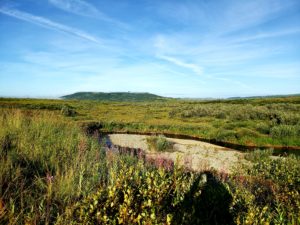
For the past 3 years, we have been lucky to host Karin Miller & her husband Erik Fischer at Rapids Camp Lodge. Karin owns Zen Tenkara out of Fort Collins Colorado and has been showing us the different applications for Tenkara fishing in Alaska the past few seasons. After her most recent trip, Karin sat down and explained to us how Zen Fly Fishing Gear came to be and how the sport of Tenkara is growing from just small streams and native trout to Alaska and even saltwater species.
–First off, give us a quick rundown of how you got started fishing with a Tenkara set up and how Zen Fly Fishing Gear came about.
Karin – “Zen Fly Fishing Gear/Zen Tenkara has been in business since 2011. It started as a tiny project of selling rods out of the trunk of a car. The method had just been brought over from Japan in 2009/10 and Colorado had the perfect waters for this simplified style of fly fishing – small streams and trout. I’d been fly fishing for a number of years but never had the time to really delve into it – there was just so much to learn, so much gear, so much terminology, flies and knots. When I learned about tenkara, I thought “Wow! This is so much less complicated. Why didn’t somebody tell me about this years ago?” At that time only one other company was bringing in tenkara rods to the US so I thought, “Perfect time and, (being in Colorado), perfect place.” So down the rabbit hole I went.”
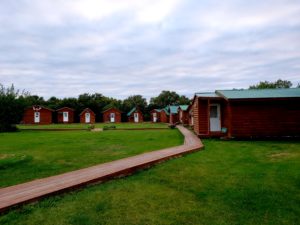 -Many of our readers are familiar with the concept of Tenkara fishing but not many have tried it for themselves. Can you give us a brief run down of Tenkara fishing? Some of the ways it differs from traditional fly fishing?
-Many of our readers are familiar with the concept of Tenkara fishing but not many have tried it for themselves. Can you give us a brief run down of Tenkara fishing? Some of the ways it differs from traditional fly fishing?
Karin – “Tenkara is an ancient Japanese fixed-line fly fishing method that’s finding its way back into the hands of modern day fly anglers all over the world. Tenkara rods are very flexible and have no spine or belly like traditional fly rods do, allowing them to bend and flex in all directions. They have no guides to thread the line through and no reel is used. Instead the line is attached directly to the tip of the rod where a cord or “lillian” is affixed, and a line is attached by means of a girth hitch. Set up is quick and since tenkara rods are telescoping and collapse to approximately 20”, they are easily transported. This simplified method of fly fishing is highly effective and excels in small water and streams yet can also be used on larger fish species in both fresh and saltwater. Tenkara focuses on the fundamentals of presentation and fish management skills. So, whether you’re a novice fly angler or a seasoned and highly skilled fly fisherman, tenkara offers up a challenge in a fun and exciting way.”
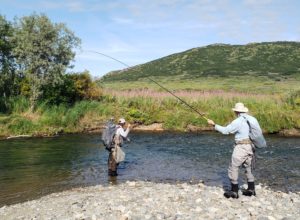 -When I think of Tenkara fishing, I picture pocket water on high mountain streams for small native trout yet here you are hosting 3 different trips to Alaska where the rivers and the trout are both very large. How does your approach differ when you get into large bodies of water like Alaska? Is it similar to traditional fly fishing where you use larger rods and heavier line?
-When I think of Tenkara fishing, I picture pocket water on high mountain streams for small native trout yet here you are hosting 3 different trips to Alaska where the rivers and the trout are both very large. How does your approach differ when you get into large bodies of water like Alaska? Is it similar to traditional fly fishing where you use larger rods and heavier line?
Karin – “Let me first say that when we think Alaska we do typically think BIG! But there are some pretty small streams in Alaska. Small streams filled with big fish. Some of my favorites are Contact, Gertrude and Headwaters. These are places where casts are short because waters are narrow, even though they host big chum, silvers, kings and rainbows. These rivers are absolutely perfect for tenkara and we’re usually using about 10-12ft of line with a 9ft leader, cast on a 13ft rod. That covers everything you could possibly want to cast to at those locations. But you’re right, in many places the water is big and wide like the Naknek, Kvichack, or the Kulik and a longer cast is critical, and of course, a heavier rod and line setup. When I come to RCL I bring 3 different tenkara rods: the Sagi, the Taka and the Kyojin. These rods have a FRAE (Fly Rod Approximate Equivalency) Rating of between about 6/7wt and 8wt. These tenkara rods are designed for bigger fish and can bear bigger loads. They can also cast longer and heavier lines than what you typically think of for tenkara. At Zen we’ve created this sort of fusion between tenkara and regular fly fishing: We’re using tenkara rods made of the highest IM carbon fiber available, which makes our rods super strong and super light. Then we’re pairing these rods with grain weight matched fly line to cast 20′-30′ lines plus leader and set up. In most cases fish are netted by guides, but I’ve had several instances when I’ve had the pure pleasure and honor of hand-lining them all the way in. And let me say, bringing in a 15lb chum that way is pretty exciting. That’s where the Zen comes in.”
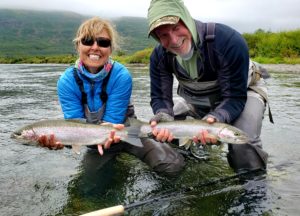
–Walk us through fighting and landing large fish without a reel?
Karin – “It’s really all about the basics of fish management skills, the fundamentals. That’s why it’s so intriguing and that’s why it works. You’re using the same principals and skill set that you use with a reel, steering and managing the fish by controlling its head. With tenkara, the moment the fish takes the fly, he’s on. He can’t run because there’s no where to go and no extra line to take. At this very moment, what’s most critical is getting the rod into what we refer to as “the power curve” and maintaining tension on the fish through the curved position of the rod. If the rod straightens, you lose power, you lose control and you lose the fight. During the entire time you’re working to stay in the curve and simultaneously steering the fish into your landing zone. If he starts to run, you use the same mechanics as you would with a reel if there was an obstacle downstream such as a downed tree or log, or a situation in which you couldn’t let the fish run. I call it fish judo: you use the fishes own momentum and power to steer and turn him where you want him to go, which is generally out of strong current and into shallow softer water. As you do this, you’re working with the fish while maintaining control and never ever loosing tension or your rod bend. Tenkara rods are extremely sensitive so every movement the fish makes is transferred directly up that blank in to your hand. There’s no reel to absorb anything and dull the sensations. You can anticipate their runs and hook throws. It’s a very tactile and exhilarating experience through and through. And believe it or not, as heart pounding as it is, the landing of these big fish, are typically quicker.
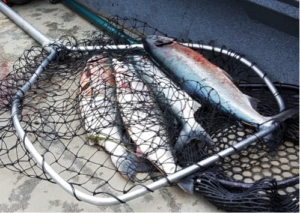
–Are you using the same flies as tradition fly fishing?
Karin – “Yes, yes, yes. I tell guides I work with and anglers all the time, once you get the line figured out, your setup is exactly the same as if you were fishing with a reel. Sometime weight is a consideration. Depending on your line, weight, length and casting conditions a really heavy fly can be tougher to get in the air. Often I’m using a type of spey or partial spey cast to lift my line and get my fly out there, particularly when the wind is howling, since you cant shoot or haul.”
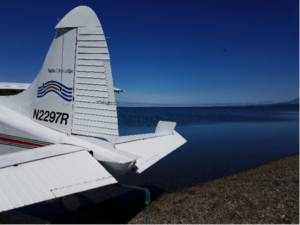
–Can you Tenkara fish in Saltwater? When is the first Andros South hosted trip? 🙂
Karin – “You sure can. I bonefish with Zen Tenkara Rods often in Mexico where I have a house. I’ve landed tarpon and even permit on tenkara – mind you, these aren’t 40lb fish. Bonefish in Mexico tend to be smaller than your Bahamian bones. They run in the 3-4lb range. But we’re landing tons of them with ease. We landed 5 permit so far too. Again, not massive permit, juniors the size of a large dinner plate. But heck that’s what we had to throw at and we landed them….and they’re still crazy powerful permit. We’ve also got into triggers and blue fin in the Maldives Islands and jack crevalley in Costa Rica. Oh, and machaca which are a blast to target as well – a very strong and aggressive fish. We’d love to do a trip to Andros and see what the rods can do down there. I know they have a limit as all rods do. And I own and use reels as well. What we really like to do is combination trips where people can use both methods and maybe get instruction and an experience with tenkara like nowhere else. Fish with your rod and reel, land lots of fish, then play and experiment with tenkara. Learn something new that’ll really hone in your skills on your regular fly rod. Experience an adrenaline rush like never before. That’s what I’m all about and what we want our tenkara adventures to be all about. Having fun, making your heart pound and getting just a whee bit crazy.”
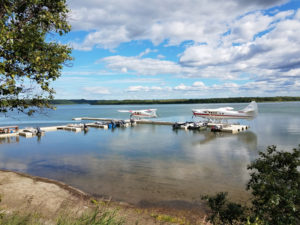
–Do you have a recommended set up for first time Tenkara anglers? What about for Tenkara Anglers heading to Alaska?
Karin – “Generally I tell people to work their way into the big stuff gradually, since a lot of that success will depend on the anglers understanding of their tenkara rod and it’s flex. And remember, not all tenkara rods are designed for Alaska, in fact, most are not. So don’t try to land a king salmon on a tenkara rod designed for catching 6″ brook trout. Our Zako Tenkara rod is our 5wt equivalency. It’s a broad range rod that’s delicate enough for the little stuff in small streams and can still handle the surprise 22” rainbow that you weren’t expecting. It casts both delicate tenkara level lines, furled and braided lines and tenkara floating lines, as well as traditional fly line up to 6wt. Start with lighter tippet, 6x and 5x for rod protection then work your way into heavier, bigger stuff. The better your skill, the heavier the tippet, up to 3x and you’re safe. For Alaska that’s a little tricky since there are opportunities for a variety of fish. I really like the Zen Sagi for rainbow and grayling, especially in the Narrows – what an amazing place. If you go for sockeye, kings or chum, you’re going to want either the Zen Kyojin or the Zen Taka. These rods are very strong and have backbone to fight. Lines are where all the creativity and knowledge comes in and where your guide’s expertise matters. Currently, we’re creating lines from regular fly lines, cut to length. But Zen is in the process of offering lines specifically designed for our bigger rods for these non-traditional tenkara species, complete with connection loops and all. So having a variety of lengths and 2 or 3 weights to accommodate different conditions and fly patterns is a good idea. The Taka cast lines weights from 6wt-8wt. The Kyojin needs a heavier line in the 8wt-12wt range depending on the conditions. Then, the setup from the line down is generally the same as you would with a reel. You just need to figure out the length of line, on average, you’ll need to get the job done and figure in your leader length into this. It’s easier than you think.
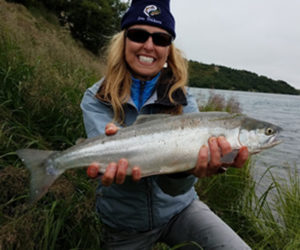
–If you had one week to fish for yourself in Alaska, British Columbia, or the Bahamas, where are you going?
Karin – “That’s tough because I’ve fished Alaska 3 times so far and each time fall deeper in love with it. Alaska is just so beautiful, untamed and has so many incredible fisheries. I’ve never been to British Columbia and love adventuring to new places for new experiences, so that’s a definite pull. On the other hand, I’m from South Florida and my father lived on a boat. We travelled to the Bahamas regularly, in fact he attended 36 Island Regattas down in Great Exuma and even sunk a yacht off of Bimini, so I have a history and special affection for the Bahamas. But get this, I’ve never fly fished there! Hmmm, do I have to pick one? It would be a toss up between British Columbia and the Bahamas. Considering the recent hurricane catastrophe, if fishing the Bahamas would help their fishing industry and they were ready and desired that, I would chose there.”
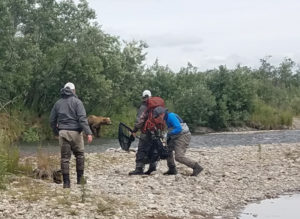
–Thank you so much for taking the time to sit down with us Karin! You have me sold, I need to give Tenkara a try! For more information on Zen Fly Fishing Gear, check out their website here!




Thank you Rapids Camp Lodge for another amazing adventure!